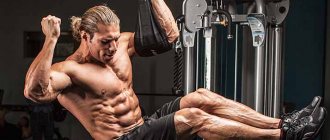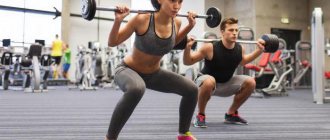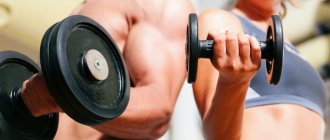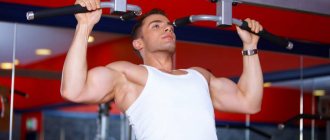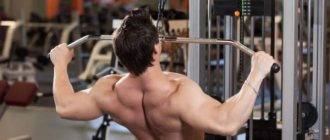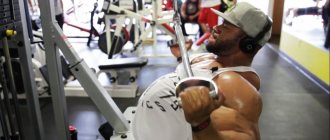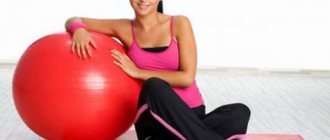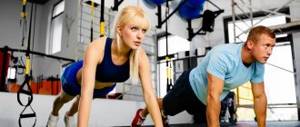Dynamics and statics: main differences, advantages and disadvantages
Dynamic training involves moving the body or its individual parts in space. The list of classical dynamics includes jumping, running, push-ups, swings, bending, swimming, cycling and dancing. In the process of performing static exercises, parts of the body are fixed in a certain position for some time. Examples include planks on the palms, toes or elbows, fixing the legs in a standing or lying position, asanas in yoga. Dynamics and statics have a number of advantages and disadvantages. The main advantages of dynamic exercises include:
- intensive increase in muscle mass;
- toned body shape;
- prevention of congestion in the musculoskeletal system;
- activation of metabolism;
- improving the functioning of the cardiovascular, respiratory system, joints.
Pros of static training:
- strengthening the body's defenses;
- stimulation of the removal of toxic substances;
- active saturation of blood with oxygen;
- no need for a large space.
It should be borne in mind that statics do not contribute to external muscle work, and muscle growth cannot be achieved with its help. Some dynamic exercises may be undesirable or prohibited in case of diseases of the musculoskeletal system, diseases of the heart and blood vessels. Dynamic load in some cases requires significant free space or special training equipment.
Static loads and their types
Thanks to the experiments of T. Hettinger and E. Müller, in 1953, static exercises (also called isometric) gained wide popularity among bodybuilders all over the world.
The essence of such exercises is muscle tension, in which the athlete’s body and limbs do not move in space, and the joints are fixed at a certain angle. To achieve this fixation, chains, ropes, various fixed supports, as well as weights weighing more than one time maximum of the athlete are used. An example of a static load would be lifting and holding a power apparatus (or your own body weight) motionless for a selected period of time, or until muscle failure occurs. It is important to realize that isometric training cannot be used constantly, they are only intended to add variety to training, since during static exercises the muscles receive too much load and they need more time to recover, otherwise overtraining may occur. In addition, in order to avoid muscle adaptation to constant, same-type loads, it is necessary to periodically change and supplement your training system.
Static loads are not always used in their pure form; they are often combined with dynamic ones. Thus, there are three main groups of isometric exercises:
- Truly static – when the load is provided by the irresistible force of resistance of the selected “simulators”;
- Dynamic exercises performed with weights, with the limbs fixed for a certain period of time (this way maximum muscle tension is achieved)
- Exercises performed using maximum weights (maximum weights).
As a result of combining the strengths of dynamic and isometric loads, there is also a system of combined “static-dynamic” exercises.
Static loads are most often used when performing bench or standing presses, biceps curls, various types of deadlifts, squats, and calf raises. The duration of static exercises also varies: short - usually from five to seven seconds, medium - from eight to eleven seconds, long - over twelve seconds. For athletes working with more moderate weights (75-85% of one-time maximum), static loads lasting 30-60 seconds are acceptable, provided that this time becomes the only approach followed by another exercise. This is a strength load, but if you hold the weight for more than a minute, the exercise becomes anaerobic, and the muscles no longer work on strength, but on endurance.
When performing static exercises correctly, the athlete exerts effort while inhaling, the tension in the muscles increases gradually, remaining maximum for no more than two to three seconds. The optimal number of approaches is two to three.
As before, static exercises currently cause a lot of controversy among their adherents and opponents. By the way, opponents of such loads are often people who strive to obtain maximum visible results in muscle mass gain in the shortest possible time. Usually their training leads to negative consequences and overstrain of the body as a whole due to improper execution and use of isometric exercises. So, if you decide to use static loads in your training system, remember that they are only short-term aids and must be alternated with dynamic loads.
So, let's take a closer look at the advantages and disadvantages of using isometric exercises.
Optimal combination of dynamics and statics
Statistical and dynamic exercises must be carried out taking into account their strengths and weaknesses, and the health indicators of the trainee. Most of the sports session should be devoted to active movements. This is especially true for representatives of the fair half of humanity. The recommended proportion of dynamics and statics is 70% - 30%, respectively. For men, the overall training content can be increased by static work from 30 to 40%.
At the initial stage, experts advise not to include statistical exercises in classes at all. This is due to the fact that in an untrained person the tendons and the places where they connect to the bones are poorly developed. In the first two months, it is better to focus on dynamics, partially connecting statics, and gradually increasing it to 30 or 40%. Statistical and dynamic loads in harmony is the secret to successful sports. The dynamics are shown for women, men and even small children. At the same time, in no case should we forget about the role of proper sleep, nutrition and rest. Only in this case can you get all three components: a flexible, toned body, healthy internal organs, vitality and a positive attitude.
Best fat burning dynamics for women
Representatives of the fair sex are recommended to work with their own body weight during training.
The main principle is to perform the exercises correctly, to tense the necessary muscles to their full amplitude. Another important aspect is the exclusion of fast carbohydrates from the diet.
Basic set of dynamic exercises
Traditional training movements for burning excess mass and developing strength include positions:
- Lying on your back, right leg extended towards the ceiling. Lower it to the right and left, the foot touches the floor. Then change legs.
- Half squat, straight arms resting on the floor. The right leg is pulled back and straightened. The left one remains in a bent position, slightly set back with emphasis on the toe. Legs slide along the floor, changing places.
- Deep squat, stand up, sharply straighten your right leg forward, squat down again, do the same with your left leg.
- Lying down, as in a push-up, on your fists, limbs straight, rising in turn.
- “Bridge” position, arms slightly bent, rocking movements from side to side.
Dynamic exercises for a flat stomach
For many representatives of the fair sex, one of the pressing problems is abdominal training.
The rule should apply here: not too much, but wisely. Below are examples of loads that are aimed not at increasing the thickness of the “cubes” and “drying”, but at stimulating the growth of white fibers responsible for a flat, beautiful tummy. Single-set training and a slow pace are best suited for this. The complex includes twists:
- Straight - lie down, bend your knees, place your feet on the floor, cross your arms over your chest. Raise your upper body 30 degrees, keeping your lower back pressed to the floor. The exercise is performed slowly, without straining the neck. There is no need to strive for quantity; 9-30 repetitions will be quite enough.
- Reverse – in the “lying down” position, slightly bent legs raised up, legs raised strictly perpendicular, lower back lifted off the floor, abdominal muscles should be kept tense.
- In the simulator - sit down, grab the handles of the apparatus, pull your head towards your pelvis, do not reach the full folding point, and gradually return back.
If you have injuries and back pain, slipped discs or osteochondrosis, you should consult a doctor before performing the complex. Don’t also forget that the abs are not trained separately from the lower and upper body. You definitely need to add aerobic exercise.
What exercises to do
Deep Lunge
Stand upside down - push your pelvis up, straighten your arms and stretch your back into one straight line. If you can't straighten your spine, bend your knees slightly and lift your heels off the floor. Rock in this position, stretching your shoulders.
Lunge forward with your right leg, place your foot next to your palm on the outside and make several springing movements. Return to the “slide”, stretch your shoulders, feel the stretch in the back of your thigh. Repeat the deep lunge with your left leg and return to the starting position.
From bending to squatting
Stand straight, place your feet shoulder-width apart. Lean forward and grab your toes. Rock, deepening the angle and feeling the stretch in the back of your thighs. Keeping your back straight, lower yourself into a deep squat, turn your knees out to the sides, and open your chest. Next - back to the starting position. Do two or three bends and straighten up.
Dynamics of Zass for men
The movements are focused on training tendon strength. They pass with a burden, the role of which is played by a pillow-shaped bag filled with sawdust. The weight of the equipment is 4-7 kilograms. During training, the weight of the gravity increases. For this purpose, a handful of sawdust is replaced with a handful of sand of the same volume. Execution rules:
- Place the bag on the floor, in front. Bend over, legs slightly bent, take the load and lift it to your chest. Pause, push your arms straight up, then lower them to your chest and floor.
- Hold the load on your chest by squatting and at the same time doing a straight arm press up. Stop at the top point, return the load to the chest area, straighten the lower limbs.
- The arm is slightly bent at the shoulder, the elbow is moved to the side, the bag is on the palm. The load is transferred from one hand to the other, making a semicircle.
- The weight is in the hands at the knees, the body and legs are straightened, the bag is thrown a meter and a half and placed on the shoulder blades and neck.
- Lying position, take the load above your head with straight arms, slowly lift it to a vertical position, put it on your chest, squeeze it up and return to the starting position.
Dynamic activities for newborns
The advantages of these trainings for kids are obvious. With their help, intestinal motility is stabilized, gas removal is normalized, stools are relieved during constipation, and the musculoskeletal system develops. Training brings parents and newborn closer together, helping to build trusting relationships. Before starting classes, you must obtain permission from your pediatrician and undergo training in the presence of a specialist. The complex, in particular, consists of the following exercises:
- Cross – move the baby’s arms vigorously to the sides, lifting the body, and return to the starting position.
- Pendulum - swinging a child from one hand to the other while transferring weight.
- Turns are made around a vertical axis, the radius increases, turns turn into rotation.
Static load - benefit or harm?
Strength exercises can be dynamic or static.
The first ones are performed in motion. At the same time, the muscles either tense or relax, and alternating contractions of the antagonist muscles occur.
With static exercises, the body is fixed in a stationary position, and constant muscle tension occurs.
During static exercises, a person's blood circulation and breathing increase disproportionately little . During rest, all indicators begin to increase, but still to a lesser extent than during dynamic load. During statics, the same nerve centers of one specific muscle group are continuously working. That is, the limiting link in this case is the higher nerve centers. This phenomenon was named after the Danish scientist Lindgard . Now there is an opinion that statics have a bad effect on the functioning of the cardiovascular system. There is some truth to this. A constantly tense muscle compresses the blood vessels, thereby impairing blood supply. It turns out that the muscle needs oxygen and energy. The heart muscle has to strain unnecessarily, pushing blood into the constantly tense muscle. As a result, blood pressure rises and the load on the heart and blood vessels increases.
Static load, depending on time and intensity, affects the body differently. It is worth noting that it is static exercises that tire the body faster than, for example, dynamic exercises.
To strengthen the musculoskeletal system, loads of large and medium duration and intensity are necessary. For hypertensive patients, on the contrary, a load of low and moderate intensity and short duration is better suited. In case of vegetative-vascular dystonia of the hypertensive type, static exercises should be used to have a depressant effect on the vessels. The intensity should be low, the duration should be short or medium. There should be a combination of exercises with voluntary muscle relaxation and breathing exercises. At the very beginning, the proportion of exercises will be 1:2:1. In the intermediate period 1:1:1. Low intensity (load) in this case will be 20-30% of the maximum. Short duration - up to 5 seconds, medium duration - from 5 to 25 seconds of operation.
Statodynamic exercises or static-dynamic ratios of 1:3 or 1:2 have a positive effect on the cardiovascular system. This has been confirmed by various studies. Static exercises should be used extremely carefully, depending on your goals and priorities. It is important here that the training program has an individual approach; in groups, only the average generalized program is usually practiced.
The most popular static exercise is the plank. There are various variations of it: on one or two legs, with or without weight. The next exercise is squats. Just not the classic one, which is performed dynamically, but the one that skiers love to do - leaning their backs against the wall and fixing their body in this position. Static load can be performed in almost any exercise, staying at some point (phase) for a short time.
Static exercises can be isometric or isotonic. With an isometric exercise, the contracted muscle only tenses, but with an isotonic exercise, the length of the muscle changes.
Isometric exercises (static) increase strength, muscle tone and endurance of muscles and tendons. They cannot be used to build muscle mass. For this, dynamic exercises are suitable, which stimulate muscle growth much more.
The main work during static load is performed half-heartedly or even less by red muscle fibers. Training these particular muscle fibers leads to a strong development of the capillary network of the muscle. Red muscle fibers get their main energy from fats. It turns out that this is a good means for burning fat, the main thing is a competent approach.
If the static load occurs with great force, then mostly white muscle fibers come into action. This develops strength and the muscles begin to increase in volume. With strong exposure, the capillaries in the muscles can become pinched, resulting in a lack of oxygen and glucose, and breakdown products are also poorly removed.
Respiratory dynamics
Used to strengthen the abdomen, diaphragm, chest. It is best to start dynamic breathing exercises with 3-7 approaches, increasing their number over time and combining them with walks in the fresh air:
- Place your hands on your belt, inhale - bend back, exhale - bend forward, while the limbs lower, the shoulders come together.
- Hands on the hips, inhale - step forward with the left leg, head slightly thrown back, right foot on the toe, exhale - the leg returns to its place, head lowers slightly.
- Hands lowered along the body, take a deep breath and raise them above you, lean back a little. When exhaling, bend forward, touching your fingers to the floor, do not bend your knees.
The most optimal time for respiratory dynamics is the morning hours.
Dynamic stretching
Exercises to develop body flexibility are aimed at accelerating the growth of muscle fibers and warming up the muscles. After performing it correctly, the main training will take place without injury. Stretching is characterized by a gradual increase in load and speed of execution. In its process you can do:
- plie squats;
- deep lunges;
- body rotations;
- bending while raising your arms;
- free swings of legs.
The absence of sudden movements allows stretching to be practiced by people whose health condition does not allow them to carry out intensive exercises.
Disadvantages of using static exercises
- the athlete’s strength increases more slowly than when performing dynamic exercises;
- with stable use of static loads, after six to eight weeks, strength stops increasing;
- for some athletes, the transition to a static training system leads to a deterioration in strength indicators;
- using only static exercises can lead to shortening of the muscle belly and lengthening of the tendons, especially in adolescents;
- there is no improvement in movement coordination and speed development;
- muscle motor skills are poorly formed, flexibility in the joints practically does not develop;
- increased blood pressure, the possibility of arrhythmia and overstrain of the heart muscle.
The fact is that during static loads, due to the fact that the muscles are under tension for a long period of time, their blood vessels are subject to compression. Because of this, resistance to natural blood flow increases, and ultimately, myocardial hypertrophy occurs - the only way the heart can adapt to increasing loads. As a consequence of this, arrhythmias may occur. It should be noted that static loads do not contribute to the development of heart vessels in the volume optimal for hypertrophy.
However, as research shows, the bulk of structural changes in the heart muscle are reversible, but often this is a limited and very difficult process. As they say, it is easier to prevent than to cure. Thus, there is a need to combine static loads not only with dynamic, but also with cardio training. This will help maintain the normal size of the myocardium, in which there will be no dissonance in the development of the heart muscle itself and the vessels that feed it.
Statodynamic training
Statodynamics is one of the most interesting sports techniques, which is gaining popularity among bodybuilders every year. Its main task is to hypertrophy oxidative muscle fibers to increase endurance and strength. The training was invented during the “golden era” of bodybuilding, and its classic scheme was proposed by Candidate of Biological Sciences, Professor Viktor Siluyanov.
The main criteria of the system include:
- short amplitude;
- mandatory refusal;
- availability of series;
- load time 30-45 sec;
- unregulated speed;
- rest for at least 10 minutes;
- only after strength training.
Siluyanov did not attach much importance to speed, while his follower Dmitry Yakovina emphasized doing the exercises slowly. This is due to the fact that during intense training, glycolytic muscle fibers are activated. To leave the GMV alone, activating the motor units of the GMV, you need to move at a slow pace. Yakovina modified statodynamic exercises, making some changes to the criteria. In his opinion, the rest time can be reduced to 5 minutes, beginners need low speed, more advanced bodybuilders work faster, there are no series. Modification of static dynamics is more adapted for powerlifting and bodybuilding.
Dynamics are beneficial for men and women. At the same time, weights are most often recommended for use by representatives of the stronger half of humanity. Which set of exercises to choose is up to everyone to decide for themselves. The main thing is that the desire for a beautiful, fit body does not negatively affect health, but, on the contrary, is in harmony with the right lifestyle and nutrition.
